
Medical Holography Market Size, Share, Trends, Market Revenue and Insights for Forecast 2024 to 2029
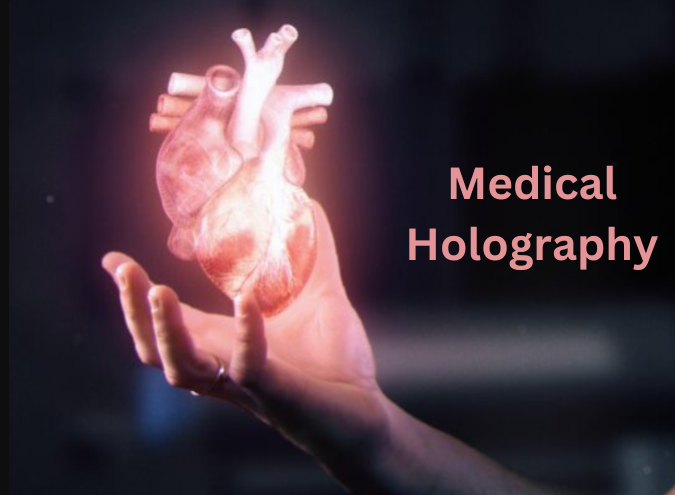
The Medical Holography Market is expected to witness a growth rate of 29% by 2029. The key factors driving the market are increasing demand for advanced medical imaging technologies, rising adoption of holographic visualization in medical education and training, growing applications in surgical planning and patient care, the advantage of using holography over traditional imaging methods and increasing adoption in diagnostic imaging. To learn more about the research report, download a sample report.
Holography is an imaging technology that employs light beams to generate three-dimensional representations of physical objects. It digitally stores information about the object's surface, resulting in intricate holographic images. These detailed images play a crucial role in mitigating the risks associated with misunderstanding and misdiagnosing medical conditions, thereby ensuring improved patient outcomes. In contrast to other imaging methods like X-rays or magnetic resonance imaging (MRI), which only provide two-dimensional images, holography captures all three dimensions, offering greater accuracy and precision. Through the diffraction and recombination of laser beams, holographic imaging presents perspective data regarding the shape, size, length, depth, and orientation of a structure, allowing for significantly more detailed visualizations compared to traditional imaging techniques.
Advancements in Medical Holography Technology drive market Growth
Advances in holographic display technology, imaging techniques, and computational algorithms have significantly enhanced the capabilities of medical holography systems. These advancements enable the creation of high-resolution, real-time holographic visualizations of anatomical structures and medical data, improving the accuracy and effectiveness of medical procedures and diagnostics. Recent developments in the illumination of 3D structures with light have enabled researchers to simulate motion, even for nanostructures, as well as having improved examination of heterogeneity within different organ systems or individuals affected by disease. This further enhances and helps improve diagnoses from levels that conventional radiography has been unable to achieve. Another highlight of holography is the rapidity with which this advanced tech delivers. The holographic process of encapsulating products and combining them with converging optical diffraction techniques and advanced image processing algorithms captures projections of patients’ anatomy within seconds, all while providing remarkable resolution imagery without compromising the integrity or accuracy of measurements. A new method called tensor holography could enable the creation of real-time holograms for virtual reality, 3D printing, medical imaging, and more. Thus, advancement in medical holography remains promising, paving the way for continued growth and adoption in the medical field. For instance,
- In February 2022, EchoPixel, announced they had received PMDA Medical Device Registration and approval in Japan for its EchoPixel True3D software platform, a pre-operative planning technology that creates a hologram of the heart for study before an incision is ever made.
- In August 2021, RealView Imaging Ltd. announced they had received FDA 510(k) clearance for its Holoscope-i holographic system. The system creates spatially accurate, three-dimensional interactive medical holograms, based on data received from standard CT scans and 3D ultrasound systems

To learn more about this report, download the PDF brochure
Growing Adoption of Holographic Medical Imaging in Various Applications Propels Market Growth
The application of medical holography spans various domains within healthcare, offering innovative solutions for improving patient care, medical education, and research. Some key applications of medical holography include:
In image-guided therapies for heart diseases: Holography has been developed into a powerful tool for medical imaging, providing high-resolution anatomical visualizations with profound clarity and precision. Holographic imaging technologies have proven to be especially useful in image-guided interventions such as cardiac ablation and left atrial appendage (LAA) occlusion enabling clinicians to visualize previously difficult-to-see structures such as blocked coronary arteries or cardiac valves encapsulated by tissue folds.
In minimally invasive, non-surgical intervention: Holography is also ushering in new possibilities for minimally invasive, non-surgical interventions. Holographic surface measurements are being used in image registration to help with surgical planning and execution. Holography can provide surgeons with a 3D map of the patient’s anatomy, allowing them to plan and perform complex procedures with more precision and confidence. For instance, holograms can help surgeons navigate around certain tissue structures and avoid unnecessary damage. Holograms can also be used to observe the status of organs or bones in real time, which can be useful for monitoring fractures or infections.
In medical training and education: The non-invasive nature of holography offers medical professionals an entirely new way to visualize and understand complex anatomical data. Doctors and students can move an image around by hand which is essential for gaining a more granular understanding of spatial measurements for procedures, treatments, and therapies. Holography can also provide virtual reality (VR) images where physicians can study highly detailed anatomy in a risk-free environment delivered via technologies such as extended reality (XR) projection platforms. Furthermore, real-time digital holography also creates high-resolution color dynamic images for medical training purposes which adds great value for learners who lack access to physical specimens or those studying biological motion like cardiac disorders.
In Remote therapy: Holographic technology facilitates telemedicine consultations and remote collaboration among healthcare providers by enabling the sharing of three-dimensional medical data and visualizations in real-time. For example, holographs can help doctors communicate with patients who have mental health issues or chronic diseases, using 3D avatars that mimic their facial expressions and body language.
Key Constraints/ Challenges
The medical holography market encounters numerous challenges and limitations. Significantly, the high expenses linked with holographic display systems pose a notable obstacle. Additionally, holograms entail higher costs compared to conventional 2-D imaging methods, necessitating costly hardware and software for the generation and viewing of multidimensional human body images. Furthermore, hologram technology remains less prevalent than other imaging techniques and demands highly skilled personnel for hologram creation. Further constraints include the technical intricacies involved in image acquisition and processing, substantial storage requirements, time-intensive procedures, and regulatory obstacles concerning the approval of medical devices and compliance with healthcare standards.
North America Expected to Continue to Hold a Major Share in the Medical Holography Market
From a geographical perspective, North America holds a major market share of the Medical Holography Market. This can be mainly attributed to the growing adoption of hologram technology for the visualization of 3-D or 4-D images of human parts, growing investments in healthcare innovation, the advantage of using holography over traditional imaging methods offering better usability, greater accuracy, and fewer risks, and increasing demand for holographic simulations, and models to enhance medical education and training in the region. However, the Asia-Pacific region is expected to witness strong growth in the coming years due to the increasing adoption of holography in diagnostic imaging, growing application in minimally invasive, non-surgical interventions, and raising awareness of the benefits of holographic applications in medicine in the region.
Competitive Landscape
Some of the key players operating in the market are RealView Imaging Ltd., EchoPixel Inc., Ovizio Imaging Systems, Eon Reality, Holoxica Ltd., GigXR Inc., Bruker Corporation, zSpace Inc., Lyncee Tec, Nanolive SA, HolographicMD, among others.
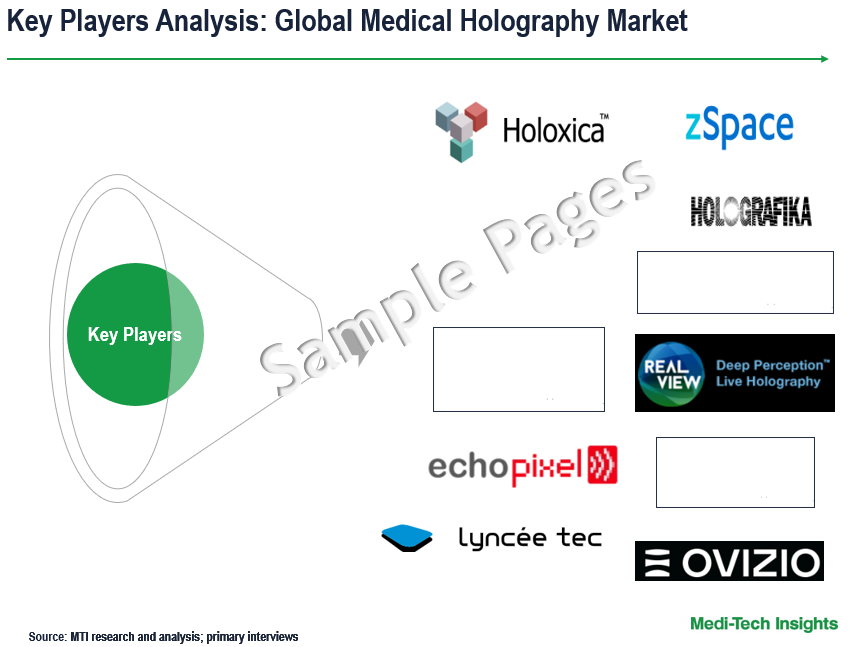
Get a Sample Report for Competitive Landscape Analysis
Organic and Inorganic Growth Strategies Adopted by Players to Establish Their Foothold in the Market
Players operating in this market are adopting organic and inorganic growth strategies such as launching new products, acquiring related firms, and entering into mergers & collaborations to garner higher market share. For instance,
- In October 2023, GigXR, Inc., a global provider of holographic healthcare training, entered into a partnership with the National University of Singapore (NUS Medicine) to introduce a new gastrointestinal module for the award-winning HoloScenarios application. Created to better prepare medical and nursing students in diagnosing and treating acute gastrointestinal diseases
- In February 2023, Light Field Lab developers of the SolidLight holographic display platform announced that they have secured a fund of $50 Million Series B led by global game developer NCSOFT
- In June 2022, Bruker Corporation announced the release of the NeuraLight 3D Ultra to support advanced neuroscience and optogenetics research applications on Bruker’s Ultima multiphoton microscopes. NeuraLight 3D Ultra provides revolutionary 3D holographic photostimulation, specifically optimized for functional and large-scale studies of neural networks and brain computation
The medical holography market is a rapidly evolving industry that is expected to gain further momentum in the coming years due to the availability of advanced medical visualization technologies, a strong emphasis on developing new products, and aggressive organic and inorganic growth strategies followed by the players.
Key Strategic Questions Addressed
-
What is the market size and forecast for the Medical Holography Market?
-
What are the historical, present, and forecasted market shares and growth rates of various segments and sub-segments of the Medical Holography Market?
-
What are the major growth drivers, restraints/challenges impacting the Medical Holography market?
-
What are the opportunities prevailing in the market?
-
What is the investment landscape?
-
Which region has the highest share in the market? Which region is expected to witness the highest growth rate in the next 5 years?
-
Who are the major players operating in the market? What is the competitive positioning of key players?
-
Who are the new players entering the market?
-
What are the key strategies adopted by players?
-
Research Methodology
- Secondary Research
- Primary Research
- Market Estimation
- Market Forecasting
-
Executive Summary
-
Market Overview
- Market Dynamics
- Drivers
- Restraints
- Opportunities
- Industry Speaks
- Market Dynamics
-
Medical Holography Market- Size & Forecast (2022-2029), By Product
- Holographic Displays
- Holography Microscopes
- Holographic Prints
- Holographic Software
-
Medical Holography Market- Size & Forecast (2022-2029), By Application
- Medical Imaging
- Medical Education
- Biomedical Research
-
Medical Holography Market- Size & Forecast (2022-2029), By End-Users
- Academic Medical Centers
- Hospitals & Clinics
- Research Laboratories
- Pharmaceutical & Biotechnology Companies
-
Medical Holography Market- Size & Forecast (2022-2029), By Region
- North America (U.S. & Canada)
- Europe (UK, Germany, France, Italy, Spain, Rest of Europe)
- Asia Pacific (China, India, Japan, Rest of Asia Pacific)
- Rest of the World (Latin America, Middle East & Africa)
-
Competitive Landscape
- Key Players and their Competitive Positioning
- Competitive Positioning of Key Players (2023)
- Offerings Assessment, By Players
- Key Strategies Assessment, By Player (2021-2023)
- New Service Launches
- Partnerships, Agreements, & Collaborations
- Mergers & Acquisitions
- Other Developments
- Key Players and their Competitive Positioning
-
Key Companies Scanned (Indicative List)
- RealView Imaging Ltd.
- EchoPixel Inc.
- Mach7 Technologies Pte. Ltd.
- Ovizio Imaging Systems
- Eon Reality
- Holoxica Ltd.
- zSpace Inc.
- Lyncee Tec
- Zebra Imaging
- Nanolive SA
- HolographicMD
- Other Prominent Players
The study has been compiled based on extensive primary and secondary research.
Secondary Research (Indicative List)
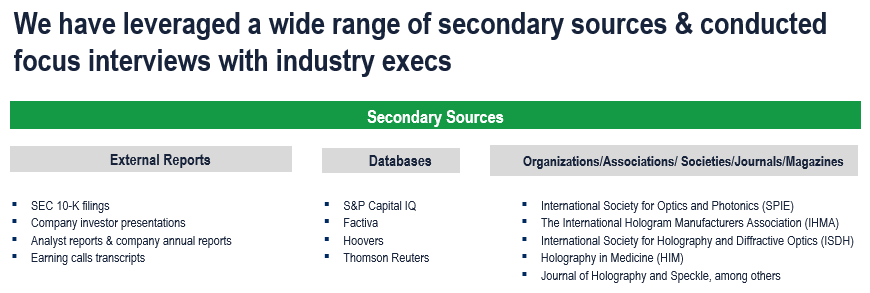
Primary Research
To validate research findings (market size & forecasts, market segmentation, market dynamics, competitive landscape, key industry trends, etc.), extensive primary interviews were conducted with both supply and demand-side stakeholders.
Supply Side Stakeholders:
- Senior Management Level: CEOs, Presidents, Vice-Presidents, Directors, Chief Technology Officers, Chief Commercial Officers
- Mid-Management Level: Product Managers, Sales Managers, Brand Managers, Business Development Managers, Consultants
- Demand Side Stakeholders: Hospitals and Clinics, Academic Medical Centers, Research Laboratories, and Pharmaceutical & Biotechnology Companies, Among Others
Breakdown of Primary Interviews
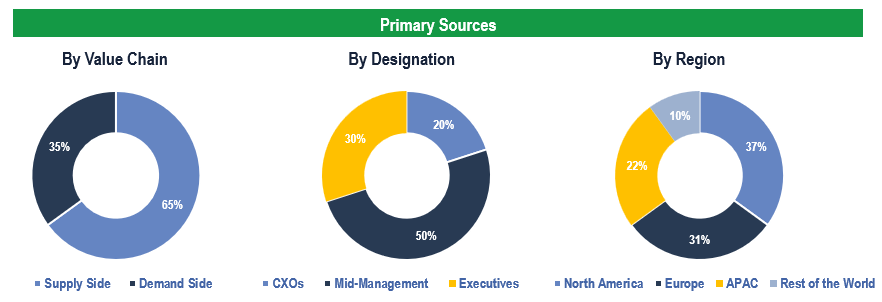
Market Size Estimation
Both ‘Top-Down and Bottom-Up Approaches’ were used to derive market size estimates and forecasts.
Data Triangulation
Research findings derived through secondary sources & and internal analysis were validated with Primary Interviews, Internal Knowledge Repository, and Company Sales Data.
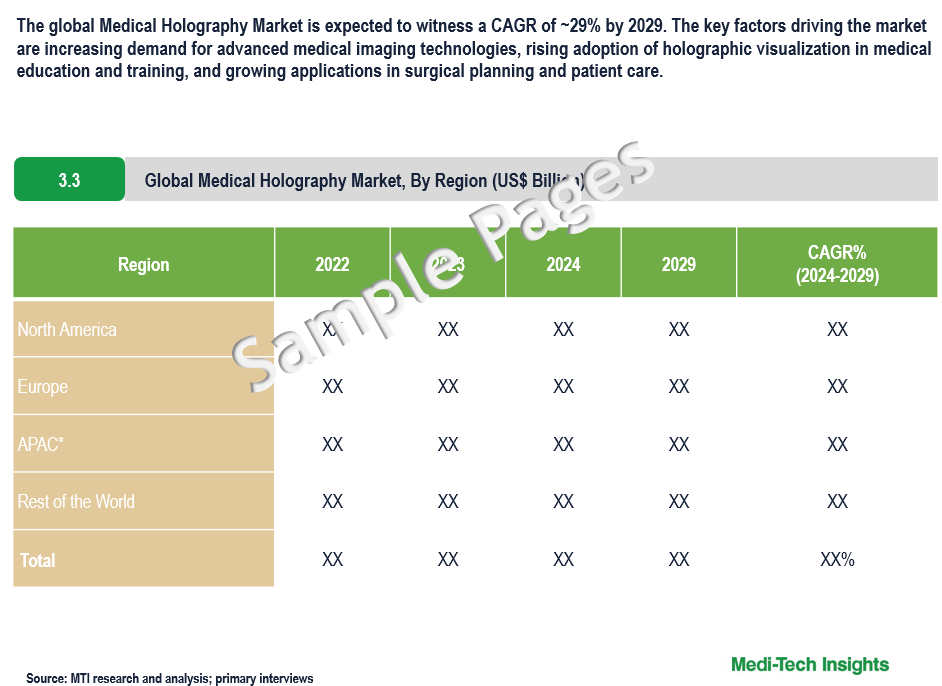

Get a Sample Report for Competitive Landscape Analysis

